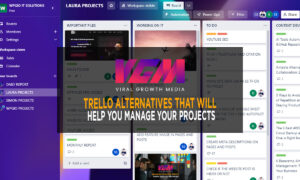Project management is a critical component of any business. Effective project management can mean the difference between success and failure, whether you’re a small business just starting or a large corporation. This blog post will discuss 6 Basecamp alternatives for project management. Each option has unique features that make it perfect for different businesses. So, whether you’re looking for a cloud-based solution or a more customizable option, we have you covered!
Project management software is a tool that helps businesses plan, track, and executes projects. It can be used for various purposes, such as project planning, resource allocation, task management, and communication. There are many different project management software solutions on the market today. However, not all of them are created equal. In this blog post, we will discuss six alternatives to Basecamp that are perfect for different types of businesses.
-Asana is a cloud-based project management solution perfect for small businesses. It offers a variety of features that make it easy to use, such as task lists, calendar views, and email notifications. Asana integrates with many popular business tools, such as Google Drive and Slack.
-Podio is a cloud-based project management solution that offers a high degree of customization. Podio allows businesses to create workflows and add custom fields to track data. It also provides various features, such as task management, file sharing, and team chat.
-Smartsheet is a cloud-based project management solution that offers powerful features for enterprise businesses. Smartsheet provides enterprise-grade security and compliance features and the ability to scale to millions of users. It also provides real-time collaboration, Gantt charts, and resource management.
-Trello is a simple Kanban-style project management solution that is perfect for small businesses. Trello uses boards and cards to help companies to visualize their projects and track progress. It also offers task lists, due dates, and file attachments.
-Wrike is a cloud-based project management solution that offers a variety of features for small businesses. Wrike provides task management, team collaboration, and real-time updates. It also offers the ability to create custom workflows and add comments and @mentions to tasks.
-Zoho Projects is a cloud-based project management solution that offers a variety of features for small businesses. Zoho Projects provides task management, Gantt charts, time tracking, and file sharing. It also offers the ability to create custom workflows and add comments and @mentions to tasks.
Basecamp is a trusted name when it comes to project management. This is because their products are phenomenal, and their team has helped pioneer some of the hailed current best practices in teamwork and web design. For example, have you heard of Ruby on Rails? It’s an open-source web application framework created and used to build Basecamp!
The Basecamp platform has a wide range of features designed to improve communication and productivity for project teams. First and foremost, the platform is user-friendly, with a clean interface and simple workflows. Additionally, the platform isn’t overloaded with new features.

What is project management?
Project management is the process of organizing, scheduling, and executing a project. It includes setting goals and objectives, defining roles and responsibilities, and creating a timeline for completing the project.
There are many benefits to using a project management tool like Basecamp. Project management tools can help you:
– Stay organized and on track
– Communicate with team members effectively
– Reduce stress levels
– Save time and money
Basecamp’s universal search feature.
These features are easy to customize and work in various use cases. Basecamp has been used by organizations in almost every industry, with notable customers including NASA, Habitat for Humanity, Etsy, and Petco. It isn’t a full-blown enterprise project and portfolio solution, and it isn’t an agile development tool, but it never pretended to be, either.

Task management in Basecam:
The program’s cost varies depending on whether it will be used by teams internally or with clients. With no limit on the number of users for any product level, Basecamp is a money-saving solution. If you’re trying to decide whether or not to purchase Basecamp as your following project management software tool, keep reading. In this article, we’ll compare six other options that provide similar features at a comparable price.
Asana:
Asana was founded in 2009 and has long been a favorite among project teams. What’s unique about Asana is that the basic version (for groups of up to 15 people) is free to use. The platform provides a single workspace where your team can share and collaborate on projects, tasks, and documents. You can also invite guests from outside the company to join and collaborate on work. Asana Premium is priced per user per month and adds priority customer support, administrative controls, and single sign-on.
Similar to Basecamp, Asana’s strength is its flexibility and ease of use. You can turn conversations into tasks, track progress through project dashboards, and set customized notification preferences to keep your inbox from getting cluttered. People have used Asana to track everything from editorial calendars to leads, software bugs, or job applicants. Notable customers include The New Yorker, Uber, and Salesforce.
-Podio:
Podio was also founded in 2009 but acquired by global IT firm Citrix in 2012, which boosted funding and market presence. Podio is a customizable “work management solution” designed to streamline project communication and provide greater visibility to decision-makers. As a platform, it offers more features than Asana, but there’s no free edition.
Beyond essential task management and scheduling, Podio has several capabilities out-of-the-box that separate it from competitors:
- Social intranet: activity streams and social profiles that help users converse and connect; a shared calendar
- Built-in chat: Send and receive messages using a collapsible pane on the right side of the interface.
- Connected CRM: CRM database built directly into the platform; integrated web forms; pipeline and sales reports
- Personal dashboards: Use workspace tiles to customize data on your homepage, employee network, or workspace
-SmartSheet:
Smartsheet is one of the more unique project management tools on the list. Their spreadsheet-style interface is designed — much like a spreadsheet — to afford flexibility and accommodate various workflows. Users can share work in a sheet and subscribe to updates on entire projects or specific rows. They can also comment and upload attachments.
In addition to the spreadsheet interface, Smartsheet offers a card view, where teams can move tasks as cards through different stages of completion, similar to a Kanban tool. The card view offers custom fields and colors, so you can customize it to match your workflows. Other features include Gantt charts (unique for a light-use cloud PM tool), reports and dashboards, calendars, web forms, resource management, and native mobile apps. Smartsheet is priced per user, per month, in three tiers.
-Wrike:
With more than 8,000 customers using their paid edition, Wrike is one of the most popular solutions on the market. They bill their platform as a “work management and collaboration platform” designed to meet the needs of marketing and creative teams, project managers, and product development teams.
Most of the work you do in Wrike will center around the Timeline — a visual display of your project schedule and task dependencies. Users can create personalized dashboards and track project work through the team activity feed. Although Wrike isn’t quite an agile PM tool, by definition, it does provide a lot of features designed to match the workflows of agile teams. For example, their new “requests” feature is an excellent way for marketers and designers to field ad hoc work and increase visibility for stakeholders outside the department.
-Huddle:
Based on their industry focus and current customers, Huddle is an outlier on this list. Their cloud-based project management solution is geared toward enterprise and public sector use (government, utilities, transportation, etc.). But it’s a solid platform, hands-down, and versatile enough to work in other industries like advertising/design, publishing, high tech, nonprofit, and even retail.
Huddle users can work together to create and edit documents, share files, and manage tasks and approvals in a single location. The platform’s custom team/user permissions and document version control make it a good choice for teams that work in highly-regulated industries or regularly collaborate on official content assets. Other Huddle features include branded workspaces, universal search, activity streams, offline access, and native mobile apps.
Projecturf:
Last but not least is Projecturf. Projecturf is a smaller company, but they’ve built an excellent platform and a large customer base, including Stanford University, Spotify, DIRECTV, and eBay.
Projecturf is built around collaboration, task management, calendars, and time tracking — the standard for this platform. Users can comment on individual tasks and files or hold conversations within each project. Pre-made templates help teams get projects running faster instead of configuring every workflow from scratch. The Projecturf interface is clean and easy to navigate, with helpful filters, custom dashboards, and visual reports on project activity.
Pricing breaks down into four tiers based on features selected, built-in templates, and the number of projects you manage. Similar to Basecamp, Projecturf offers unlimited users for every edition. It’s an excellent option for fast-growing teams or companies that regularly adjust access privileges.

What Are the Pros of Using Basecamp?
Okay, so you’ve now got a better idea of what Basecamp is and some of the reasons you’d use it. Before deciding whether you want to buy the product or not, it helps to look at the benefits and drawbacks of using it.
Let’s start with the positives; you’ll find three top reasons to use Basecamp below.
-Easy to Collaborate:
Basecamp is popular because it’s easy for teams to use. The software offers a complete overview of the business’s ongoing operations and makes it simple for each team to manage their projects within a unified interface. When using Basecamp, you can also ensure that you stay in the loop by receiving notifications when someone comments on your tasks by default, and you will also see these in the “Hey!” tab.
-App Integrations:
The essential feature in a project management solution is whether you can link apps and, if so, which ones you can and cannot. You may use Basecamp with a variety of popular programs in the business.
- Slack
- Mailchimp
- Salesforce
Other tools you might want to use in conjunction with Basecamp are Google Workspace, HubSpot, and Microsoft Outlook.
-A Transparent Pricing Structure:
With transparent pricing, Basecamp offers a subscription-based service. Many software-as-a-service (SaaS) platforms have plans where you must pay for each user. This is not the case with Basecamp, however. You pay a fixed fee of $99 per month for the Business plan if you opt for a yearly payment; you may save money by paying quarterly instead of monthly, costing $999 per year.
Basecamp’s annual plan comes with an extra 500MB of storage, and if you’re not satisfied with the platform, there’s a one-year money-back guarantee. Basecamp also has specific app integrations that come at an additional cost, which is transparent on its website. Lastly, the personal version can be used for free if you don’t want to purchase Basecamp Premium. This allows 20 users, three projects, and 1GB of storage space.

What Are the Cons of Using Basecamp?
You should know what Basecamp has to offer after reading the previous sections. However, before creating an account, the disadvantages are worth considering.
We’ve listed two cons that you should keep in mind below.
-You Might Find That Projects Get a Little Messy:
Basecamp is a fantastic tool for keeping track of your company’s projects. Larger businesses, on the other hand, may find themselves losing track of everything. When you use Basecamp, you can view all recent activity in the app. While this is frequently useful, it can become immensely aggravating and stressful. You may alleviate this by switching off the emailing daily summary button in Activity.
-Basecamp Is Missing Some Useful Features:
Although Basecamp has many features that can be useful for project management, a few others could add another dimension to your projects. For example, Gantt charts might give you and your team a more precise overview of the progress of your project. However, this isn’t possible with Basecamp software. If you were looking for features like this, ClickUp might have what you’re missing.

What are the benefits of Project Management for businesses?
Project management has several advantages for businesses. It may assist companies in better organizing their operations, communicating more efficiently, and tracking progress more effectively. Project management may also aid firms in avoiding potential issues and raising customer pleasure.
If you’re still undecided about whether or not project management is necessary, read on to learn how it can help you. There are several ways to get these ideas into your team’s way of working—no fancy degree or certification is required.
-Clear, organized plans improve team collaboration:
Without a plan, projects can quickly become disorderly. You might miss key steps in the process, have to do hasty work at the last minute, or keep asking yourself and others logistical questions. Additionally, the quality of your project could diminish as you hurry to finish it.
Instead of starting your project as you go, make a timeline or list of categories to break down who’ll do what by when before you begin. Then, visualize your project’s tasks in a timeline or categorized list to clearly show who’s responsible for each step and when it needs to be completed. For example, if you’re organizing an event, you could document each stage leading up to the main event, who is in charge of each one, and how far in advance each step must be completed.
Tips for planning projects:
- Before you start, break down what you’ll need to accomplish. Next, include deadlines, task owners, state, or pointers to relevant files. Add a little slack time for unforeseen issues or delays if this is a brand new project for your team.
- Put everything into a plan that can be shared. This way, everyone will know who is doing what and when it needs to get done. You can use something as basic as a list or calendar, or if you want to get more creative, try using a timeline or Kanban board. Lastly, send the plan out to everyone involved so that everyone is up-to-date.
- Projects you know you’ll have to do more than once can be saved as templates. In the future, less time will be spent on planning these specific projects.
-Defining everyone’s role eliminates confusion:
After you’ve completed the preliminary preparation, it’s on to the main portion of project management: managing it. It’s too simple for teammates to abandon duties, forget details, and/or be uncertain about who they should ask questions to if there isn’t a clear project owner to assist them across the finish line.
Tips for managing projects:
- At the beginning of your project or during its planning, communicate everyone’s roles and responsibilities to avoid confusion later. Lead by example and tell that you are the project leader from the get-go.
- Check-in with task owners and respond to inquiries. Since you’ve established a clear strategy, stakeholders already understand their responsibilities. Now, assist them in staying on track by checking in on how their work is progressing or providing them access to anything they need to get back to work.
- By sharing status updates frequently, you will keep everyone in the loop on how the project is progressing. This will also reduce the number of questions about such updates and encourage/motivate your stakeholders.
-Well-defined goals improve team effectiveness:
Without defined project goals, teams risk working towards the wrong objective or inefficiently completing low-impact work. A project management tool allows you to define your project goals at the beginning so that everyone knows what needs to be accomplished and can focus their efforts accordingly.
You might set a few goals: “Increase installations by 20%.” This goal would influence your launch decisions as you go. It would also be a measure to assess success after the launch. The project team members will benefit as well. You’ll keep your staff laser-focused on activities that matter to these objectives—rather than wasting time on tasks that won’t make any difference.
Tips for setting project goals:
- Assess why you’re launching the project. Why does this need to be done? Who will be affected by it? How does this initiative fit in with your company’s broader objectives? Is it a good fit for other members of your team who are already doing similar tasks? What do we anticipate as a result of this effort?
- Make your goals known to all of your stakeholders. Share your objectives with everyone who will be affected by the project before you begin. You might do this in a kick-off meeting, via the distribution of a paper, or by posting it on a project management software—as long as everyone understands your initiative’s (and non-)goals.
- Setting goals is not enough; you must monitor and report on them regularly. This will help you stay on track and ensure you hit your targets. Set up a process for monitoring and reporting on your goals, so you can easily see if you’re at risk of missing any of them. Then, you can adjust your plans accordingly to ensure success.
-Defining a communication plan keeps your team aligned and focused
Project management is more than just managing a project, and it’s about being efficient and understanding how to communicate with your team before work begins. Your team likely has an email management tool, an instant messaging tool, and a project management tool – each should be used sparingly with specific purposes in mind. For example: at Asana, we use email for external communication, Slack for quick internal messages that don’t require action items, and finallyAsanafor task-oriented things everyone needs to see.
The average worker switches between 10 applications each day. Switching between numerous tools may be confusing or overwhelming when you don’t have a defined strategy for which device to utilize. Communication plans reduce decision fatigue by ensuring that everyone on the team is aware of what’s going on.
Tips for creating a communication plan:
- Establish conventions for communicating. At its most basic level, your communication strategy should describe the tools and frequency of interaction between your team.
- Opportunities for feedback should be present in your communication plan so that it can benefit everyone on your team. Make sure all the key players are compatible and offer chances for feedback and plan refinement until it’s achievable for all involved.
- Make sure you know who the project stakeholders are and what their roles are. You should loop them in at specific points during the project, and there may be some approvers who need to sign off on things before they go live. Keep track of all this information as part of your communication plan.
- Align your posting frequency and style with the topic. One of the essential components of your message strategy is how you’ll communicate project developments. All your noble work should ideally be kept in a project management tool so you can quickly compile and distribute status updates.
-Project management tools help increase efficiency:
Use a project management tool to increase productivity and better manage the projects. You have many different tools to select from, but you might want to shy away from those that require significant time investment for training and setup since they’re meant for more traditional methods. Look for something simple to use, flexible, and configurable rather than difficult to adopt. Bonus points if you can collaborate across projects (which might be difficult in email and spreadsheets) and communicate with team members about the job’s progress.
Tips for using a project management tool:
- Project success depends on having everyone using the same project management tool. When team members use different tools, it’s challenging to encourage collaboration, and essential information gets lost in translation.
- Establish standards for how to utilize it. Some easy instructions help everyone feel secure that they’re using their new tool correctly. For example, you might say “always include a due date on tasks,” “ensure to include ‘marketing’ in all marketing project titles,” or “if you have an actionable request for someone, instead of emailing them, create a task in our project management software.”
- Tool value comes from increased visibility into project statuses and progress reports. Sharing this information with your team helps them stay updated on work developments and encourages tool usage for their projects.
How do you know if a tool has all the features you need?
There are numerous things to take into account when selecting project management software. But have no fear; we’ve done the hard work for you. To help make your decision easier, here is a Basecamp alternative for project management, depending on what you need.
– Wrike is a free, feature-rich project management software that lets you stay organized and on track if you’re looking for a tool that is both cost-effective and provides a free trial.
– Smartsheet is a tool that has all of the bells and whistles you’ll need.
– If you’re looking for a product with a user-friendly interface, Trello is the place to go.
– If you need a tool that works with other programs, try Asana.
-If good customer service is a must-have for you, Podio is the tool you’re looking for.
– If you need a tool that includes project templates, try Basecamp.
Conclusion
While Basecamp is an excellent option for many businesses, it may not be the best solution for everyone. That’s why we’ve provided six perfect alternatives for different types of companies. Whether you’re looking for a cloud-based solution or something more customizable, we have you covered! Have you tried any of these project management tools? What was your experience? Let us know in the comments below!























